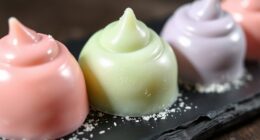Making no-churn ice cream works by controlling ice crystal formation. You whip heavy cream to add airiness, then fold in sweetened condensed milk to both sweeten and prevent large crystals. Gently mixing in flavors and freezing in a tightly covered container helps keep crystals tiny, resulting in a smooth, creamy texture. Stirring the mixture every 30-60 minutes during freezing also breaks up forming crystals. Keep exploring to discover more tips for perfect results.
Key Takeaways
- Controlling ice crystal size through ingredients like sweetened condensed milk and heavy cream ensures smooth, creamy texture without a machine.
- Whipping heavy cream creates a light structure that helps prevent large ice crystals during freezing.
- Gentle folding of flavorings and ingredients maintains airiness and prevents disruption of the ice cream’s smoothness.
- Regular stirring during freezing breaks up forming ice crystals, resulting in a velvety, scoopable consistency.
- Proper container sealing and sufficient freezing time are essential to prevent ice crystal formation and ensure quality texture.

Making ice cream at home doesn’t have to involve an ice cream maker or complicated steps. In fact, you can craft delicious, creamy no-churn ice cream with simple ingredients and a little patience. One of the key factors that influence the texture of your homemade ice cream is ice crystal formation. When you freeze dairy-based mixtures, tiny ice crystals develop, and if these crystals become too large, your ice cream turns icy and gritty. To prevent this, you’ll want to incorporate ingredients that inhibit large ice crystal growth, such as sweetened condensed milk or heavy cream, which help create a smoother, more scoopable consistency. Additionally, mixing in flavor infusions—like fresh fruit purees, chocolate, or herbs—can elevate your ice cream and make it uniquely yours. The trick is to add these flavorings at just the right stage to ensure they blend well without disrupting the texture.
When preparing your no-churn ice cream, start with a base of whipped heavy cream. Whipping air into the cream creates a light, fluffy structure that will help combat ice crystal formation during freezing. Once you have a voluminous whipped cream, gently fold in sweetened condensed milk, which adds sweetness, creaminess, and acts as an anti-crystallizer. Now’s the time to add flavor infusions—pureed strawberries, mashed bananas, or a swirl of caramel—carefully mixing them in to distribute evenly. Keep in mind that the more you stir, the more air you incorporate, which benefits the final texture.
Once combined, transfer your mixture to a freezer-safe container. To further control ice crystal growth, cover it tightly with plastic wrap or a lid, pressing directly onto the surface to prevent ice from forming on top. During freezing, periodically stir the mixture with a fork or spatula every 30 to 60 minutes for the first few hours. This process breaks up forming ice crystals and keeps them small, resulting in a velvety, scoopable ice cream. Patience is key—most no-churn recipes require at least 4 hours, but overnight freezing produces the best results.
Frequently Asked Questions
Can No-Churn Ice Cream Be Stored Long-Term?
You might wonder if no-churn ice cream can be stored long-term. It generally offers good storage longevity if you keep it in an airtight container, but freezer stability varies depending on ingredients and storage conditions. To prevent ice crystals and spoilage, guarantee your freezer stays consistently cold and limit the time it’s stored. Proper wrapping and sealing help maintain texture and flavor, allowing you to enjoy your homemade treat longer.
What Are the Best Flavor Combinations for No-Churn Ice Cream?
When choosing flavor combinations for no-churn ice cream, focus on classic pairings like chocolate and peanut butter or strawberries and cream. You can also experiment with unique flavor pairings like vanilla and lavender or lemon and blueberry. To enhance texture, add mix-ins like crushed cookies, nuts, or swirls of caramel or fruit preserves. These flavor pairings and texture enhancements make your homemade ice cream more delicious and satisfying.
How Does the Fat Content Affect No-Churn Ice Cream Texture?
You’ll notice that fat content directly impacts the ice cream’s texture. Higher fat consistency adds cream richness, making it smoother and more velvety. It also helps prevent ice crystals from forming, giving you a luxuriously creamy feel. If your mixture has too little fat, it might turn icy or grainy. To achieve the perfect no-churn ice cream, aim for a balance that enhances creaminess without making it overly greasy.
Can No-Churn Ice Cream Be Made Vegan?
Like a modern alchemist, you can turn plant-based ingredients into creamy vegan ice cream. Yes, you can make no-churn vegan ice cream by using vegan substitutes like coconut milk, cashew cream, or almond-based options. These plant-based creams mimic dairy’s richness, giving you that smooth, indulgent texture. With a little creativity, you’ll enjoy a delicious, dairy-free treat that’s just as satisfying as traditional ice cream.
Is No-Churn Ice Cream Suitable for People With Lactose Intolerance?
If you’re lactose intolerant, no-churn ice cream can still be an option. You can use lactose alternatives or dairy-free options like coconut milk, almond milk, or cashew cream to make it. These substitutes create a creamy texture without dairy, so you enjoy delicious frozen treats without discomfort. Just swap out traditional ingredients for your favorite dairy-free options, and you’re all set for a tasty, lactose-free dessert.
Conclusion
Now that you know the secret behind no-churn ice cream, you’re equipped to create creamy delights anytime without a machine. Think of it as opening a treasure chest of homemade goodness—every scoop a gem shaped by your hands. With a little patience and the right ingredients, you can turn simple ingredients into a magical treat that’s as satisfying as winning a small victory. So go ahead, embrace the art of effortless ice cream making—your taste buds will thank you.










